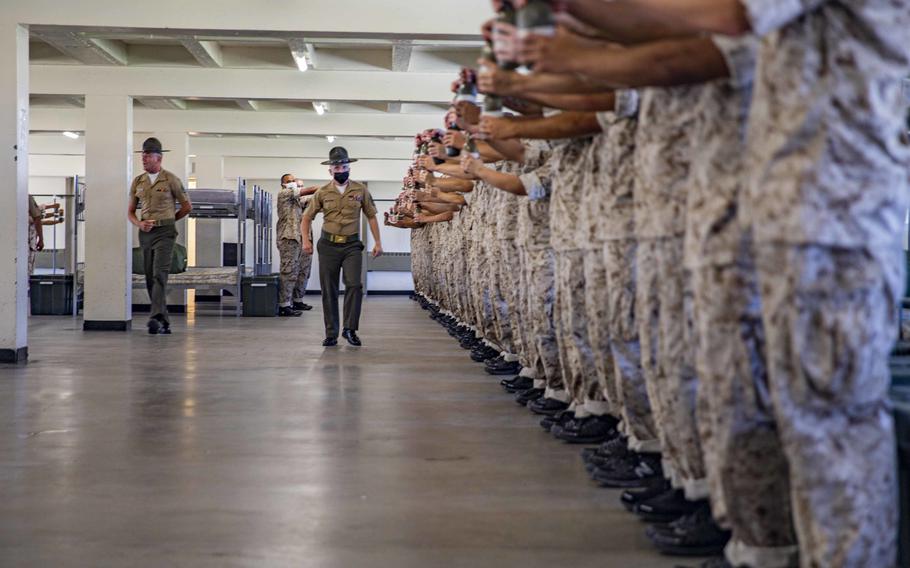
New U.S. Marine Corps recruits with Golf Company, 2nd Recruit Training Battalion, participate in the pick up process at Marine Corps Recruit Depot in San Diego, Oct. 29, 2021. (Grace Kindred/U.S. Marine Corps)
The Marine Corps released a new plan Wednesday that says it must overhaul how it recruits and retains Marines, suggesting for the first time in decades that threats posed by China and other adversaries require personnel changes that could require some shrinking of the service to accommodate a new emphasis on keeping trained personnel.
Gen. David Berger, commandant of the Marine Corps, said he sees no alternative but to pivot away from a system that through multiple wars has prioritized massing a "young, physically tough, replaceable force" that was "not all that highly skilled." For the past 35 years, Berger said, the service has turned over about 75% of its force each year, rotating annually through thousands of young enlisted Marines who join for four years, while other services retain a higher percentage of troops.
"We're the anomaly, and we brag about it — and I think it's worked for us," Berger said. "It will not work for us going forward, I don't think."
Berger said the Marine Corps is going to have to "treat people like human beings instead of inventory," making it appealing for more who already have experience to stay. There is urgency to do so, he said, because rising challenges such as China will require mature, experienced service members who possess multiple skills and can act on their own in the absence of communications with higher headquarters.
The plan — titled "Talent Management 2030" — amounts to a significant cultural shake-up for a service that once told Americans in recruiting advertisements that they were "looking for a few good men" and wouldn't "promise you a rose garden." It also calls for the service to promote equity and diversity among Marines, create "lateral" ways for people with coveted skills to join the service without starting at bottom ranks, and reduce requirements for personnel to move as frequently.
Additionally, the Corps plans to seek authorization next year to increase the duration of parental leave available to its personnel. The plan calls for primary caregivers to be able to take up to a year of leave, with a secondary caregiver receiving up to 12 weeks.
Berger left open the possibility that the service could shrink to accommodate the shift to a more seasoned force that makes more money. The plan is not meant to create a "kinder and softer" Marine Corps, he said, but to focus on quality over quantity and make it appealing for good Marines to stay in uniform.
"We're in a market for talent," he said. "So the Marine that we trained for four or 10 years, we need to work hard to keep. And if the reason that they're leaving is they can't see past either, 'I can have a military career, or I can have a family,' we have to pull out the stops to try to find ways where we can keep them."
The service has about 180,000 Marines on active duty. In a complementary plan called Force Design 2030, announced last year, Berger signaled his intention to cut the force to 174,000 Marines by 2030. At the height of the wars in Iraq and Afghanistan, the service had about 202,000 on active duty.
Berger said the service hasn't figured out how much the new plan will cost.
"Our premise is we can't afford not to do this," the commandant said. "I don't know the balance sheet yet."